Topics
Category
Era
Flooding of the Red River, 1997
Flooding on the Red River in April and May 1997 set twentieth-century records at most locations along the Minnesota–North Dakota border and into Manitoba, Canada. At the time, it was the eighth-costliest flood in US history, causing an estimated $4 billion in damages across a swath of land roughly the size of Delaware.
After an exceptionally rainy autumn in 1996, several cities along the Red River experienced as many as eight blizzards that winter, which created a ten-to-thirteen-inch pack of high-moisture snow in the southern part of the valley. On Valentine’s Day 1997, the first National Weather Service forecast for the Red River Valley warned of severe flooding. When temperatures rose, so did river levels from more than twice the average snowfall.
Grand Forks, where the local newspaper named the storms like hurricanes, saw six inches fall in Blizzard “Hannah” on April 4, 1997—the same day the river reached flood stage. Freezing rain knocked out power to more than 300,000 people across the valley.
Over the next two weeks, water continued to rise fast—sometimes as quickly as one foot per hour, far beyond flood-stage levels. Levees along the river, built to hold water back, were threatened. In the early hours of April 18, Grand Forks Mayor Pat Owens issued the first evacuation orders, with civil defense sirens sounding to wake sleeping residents. Ninety percent of the city’s 52,000 residents would be evacuated.
While flooding heavily damaged several communities along the river, including the towns of Breckenridge and Ada, Minnesota, focus remained on Grand Forks. The following day, a fire began downtown, eventually damaging or destroying eleven buildings across three city blocks. The lasting image of the flood was a raging fire atop flood waters.
On April 22, President Bill Clinton toured the area and visited victims and relief workers at Grand Force Air Force Base in Grand Forks, offering sympathy and announcing additional federal dollars for emergency response.
Flood waters started to recede in Grand Forks the day after Clinton visited. Within a month, the water was below flood stage, leaving destruction and a long clean-up across hundreds of miles of the Red River Valley.
East Grand Forks, Minnesota, a city of nearly 9,000 across the river from Grand Forks, North Dakota, ultimately reported damage to all houses except eight. By August, schools reopened—many in rented and temporary facilities, including churches and armories.
Federal relief funding initially deadlocked in Congress after a presidential veto, but more than $1 billion in funding for the Upper Midwest was finally approved on June 12. It included money to repair infrastructure and to buy and remove homes and businesses most at risk of future flooding.
More than 800 properties were purchased in Grand Forks alone through a voluntary buyout. Entire neighborhoods were removed in Grand Forks and East Grand Forks to make room for new levees, as part of a $409 federally-funded system. The result was the Greenway, nearly 2,200 acres of parks and other open space along the river intended to prevent structural damage and destruction in future floods (which is what happened when another severe flood hit in 2009).
In 2005, levees and a flood diversion channel were built to protect Breckenridge, Minnesota, and Wahpeton, North Dakota. The $45 million project prevented $165 million in flood damages between that year and 2025, according to estimates.
Fargo, North Dakota, and Moorhead, Minnesota, were “precariously close to being lost” in 1997. After another close call in 2009, efforts began to build a flood diversion channel to protect those cities. That project remains in progress as of 2025.
While more than $1 billion in flood-control projects has helped prevent the catastrophic damage sustained along the Red River in 1997, flooding remains a regular occurrence. More than half of the top ten floods recorded in Fargo and Grand Forks have happened in the past twenty years, according to former North Dakota state climatologist Adnan Akyüz.
.Bibliography
Bauer, Shannon. “District Fought Floods in Three River Basins.” Crosscurrents 30, no. 9 (October–November, 2007): 7–16. US Army Corps of Engineers.
https://usace.contentdm.oclc.org/utils/getfile/collection/p16021coll8/id/1834
City of Grand Forks. 1997 Flood Timeline.
https://www.grandforksgov.com/government/city-departments/public-information-center/1997-flood/1997-flood-timeline
“Clinton Tours Flood-Ravaged North Dakota.” CNN, April 22, 1997.
https://www.cnn.com/ALLPOLITICS/1997/04/22/earth.floods
DeLage, Jaime. “A Dark Day: Blizzard Hannah Caused a Variety of Problems.” Grand Forks Herald, April 6, 1997.
FEMA. 1997 Grand Forks Flood By the Numbers.
https://www.fema.gov/fact-sheet/1997-grand-forks-flood-numbers
Memories of 1997. The Greenway.
http://www.greenwayggf.com/1997-flood-memories.html
National Weather Service. “North Central US Flooding Red River Basin, April 1997.” https://www.weather.gov/media/publications/assessments/North_Central_US_Flooding_Red_River_Basin_April1997.pdf
NOAA. Flooding of the Red River Valley and Tributaries during April 1997. https://www.cpc.ncep.noaa.gov/products/assessments/assess_97/rriver.html
Olson, Dave. “Flood Victims Flee Ada.” Fargo Forum, April 8, 1997.
Schmickle, Sharon. “Clinton Gets His Flood Bill.” Minneapolis Star Tribune, June 13, 1997.
Shelby, Ashley. Red River Rising: The Anatomy of a Flood and the Survival of an American City. Minnesota Historical Society Press (Borealis Books), 2003.
Sip, Robert. “Past, Current Floods Reveal Red River Basin’s Needs.” Minneapolis Star Tribune, April 26, 2022.
Swanson, Ian. “One Journey Ends; Another Begins.” Grand Forks Herald, June 27, 2000.
University of Virginia. Miller Center. “April 22, 1997: Address to the people and relief workers of Grand Forks, ND.”
https://millercenter.org/the-presidency/presidential-speeches/april-22-1997-address-people-and-relief-workers-grand-forks-nd
Wagner, Cale. “Storm Stops Many in their Tracks.” Grand Forks Herald, November 18, 1996.
Welcome to the Greenway. The Greenway.
http://www.greenwayggf.com
Related Resources
Primary
OH 57
Red River Floods of 1997 Oral History Project
Oral History Collection, Minnesota Historical Society, St. Paul
Description: Interviews document the 1997 flood and its effects on the people living in the Minnesota communities along the Red River of the North. The narrators include government officials, private citizens, homeowners, business owners, weather forecasters, insurance personnel and psychologists. They discuss their individual experiences during the events of April 1997, including the flooding, the recovery efforts since the waters receded, and the issues that have been raised in planning for confronting future flooding in the valley.
https://www.mnhs.org/search/collections/record/70b338c3-10f7-4e83-a6be-751332db74a4
S4996
Floods in the Red River Valley
Minnesota State University Moorhead
Description: Correspondence, documents, oral interviews and transcripts, photographs, publications, news clippings, video and audio tapes related to the 1997 flooding of the Red River.
https://www.mnstate.edu/library/university-archives/northwest-mn/collections/s4996
Secondary
Seeley, Mark W. Minnesota Weather Almanac. Minnesota Historical Society, 2015.
Web
Ebb Tide: Recovery From the 1997 Flood in the Red River Valley.
https://www.mnstate.edu/library/university-archives/northwest-mn/collections/s4996/1997-flood-ebb-tide
Related Images
The top of a US Geological Survey staff gauge (a graduated rod against which water levels can be read) is barely visible above the water flooding Sorlie Bridge on April 21, 1997. The top of the gauge represents a water level or river stage of 54.50 feet, two feet above the 1997 East Grand Forks city levee. During the 1997 flood, the Red River crested at 54.35 feet; the National Weather Service flood stage at Grand Forks is 28.00 feet. Photo by the United States Geological Survey.
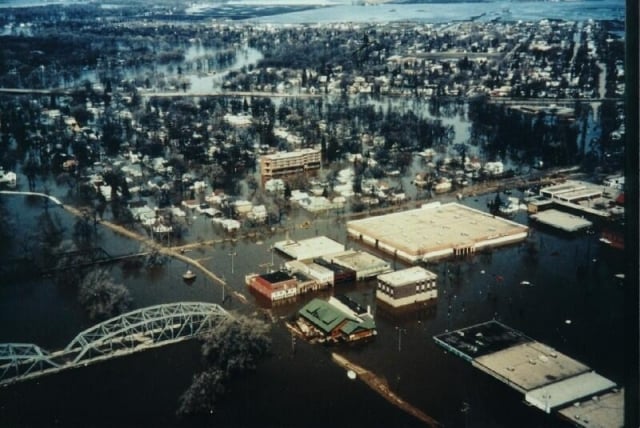
Public domain
Holding Location
Articles
More Information
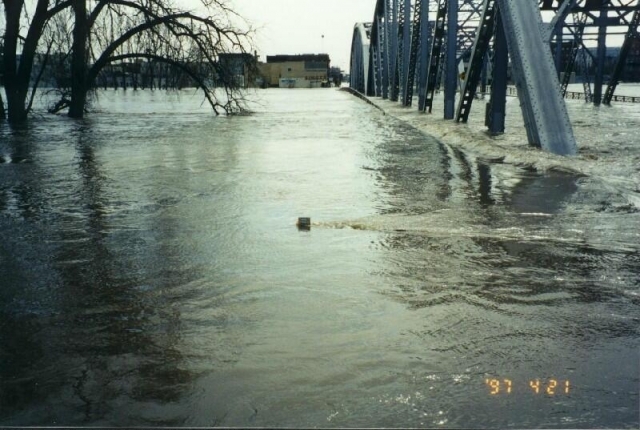
The top of a US Geological Survey staff gauge (a graduated rod against which water levels can be read) is barely visible above the water flooding Sorlie Bridge on April 21, 1997. The top of the gauge represents a water level or river stage of 54.50 feet, two feet above the 1997 East Grand Forks city levee. During the 1997 flood, the Red River crested at 54.35 feet; the National Weather Service flood stage at Grand Forks is 28.00 feet. Photo by the United States Geological Survey.
Public domain
Articles
More Information
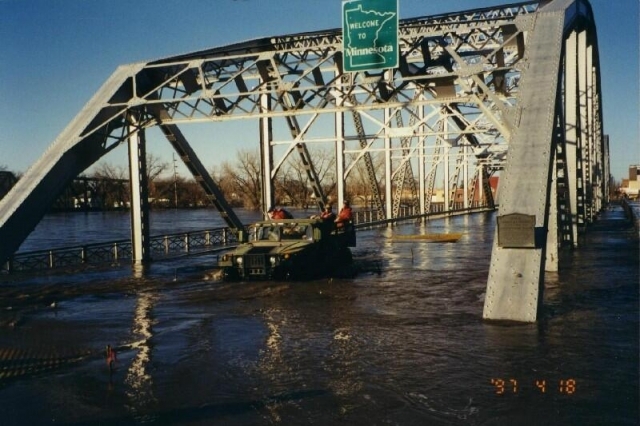
Public domain
Holding Location
Articles
More Information
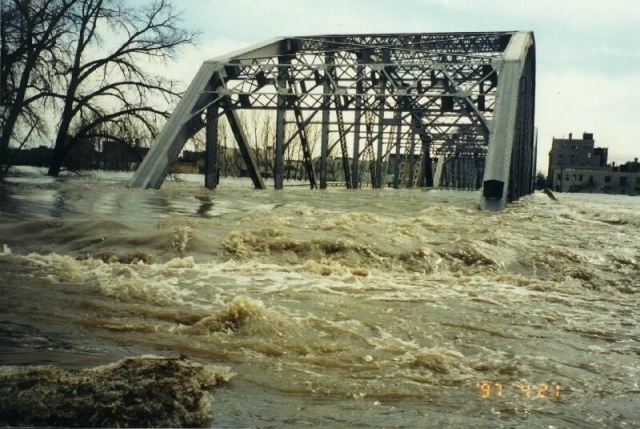
Public domain
Holding Location
Articles
More Information
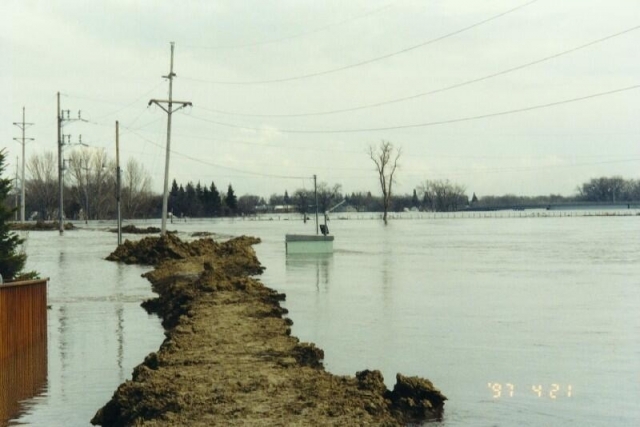
Public domain
Holding Location
Articles
More Information
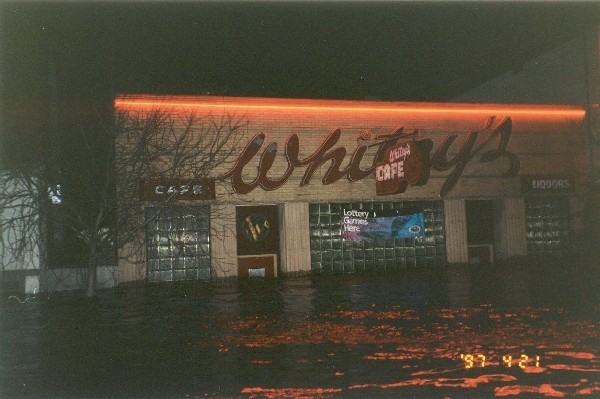
Public domain
Holding Location
Articles
More Information
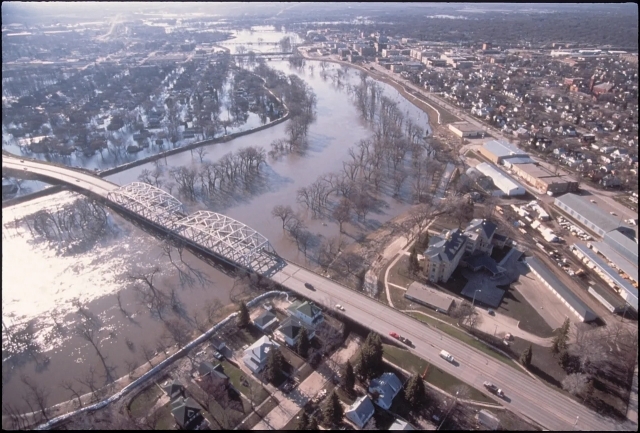
An aerial view of Grand Forks, East Grand Forks, and Sorlie Bridge over the flooded Red River, April 1, 1997. North Dakota is on the left side of the river and Minnesota on the right. Photo by Mike Rieger for the Federal Emergency Management Agency (FEMA). Public domain.
Public domain
Holding Location
Articles
More Information
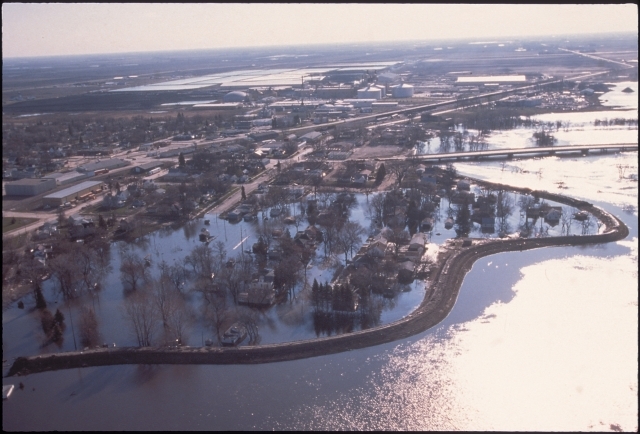
Public domain
Holding Location
Articles
More Information
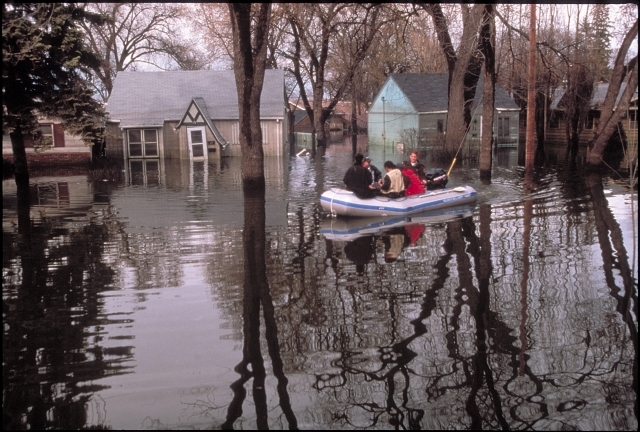
A search-and-rescue team navigates a flooded neighborhood in Grand Forks, North Dakota, on April 1, 1997. Photo by Mike Rieger for the Federal Emergency Management Agency (FEMA).
Public domain
Holding Location
Articles
More Information
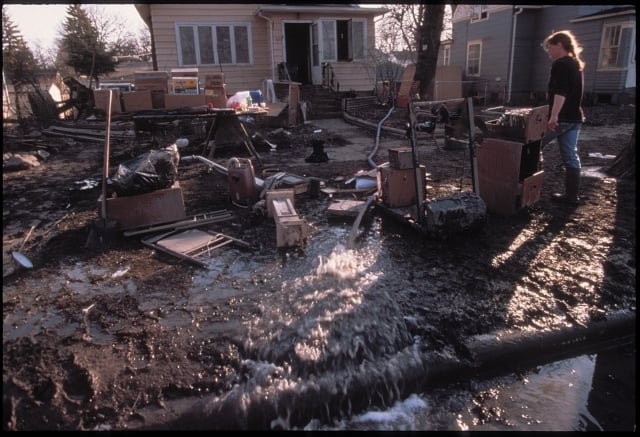
Public domain
Holding Location
Articles
More Information
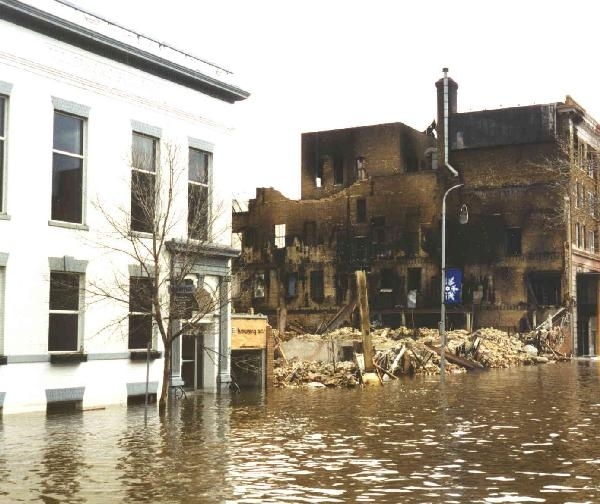
Public domain
Holding Location
Articles
More Information
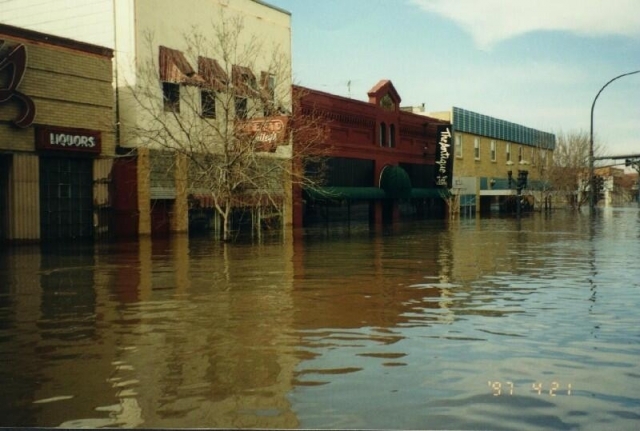
Public domain
Holding Location
Articles
More Information
Related Articles
Turning Point
Chronology
November 17, 1996
April 4–5, 1997
April 7, 1997
April 18, 1997
April 19, 1997
April 22, 1997
April 23, 1997
May 19, 1997
June 12, 1997
President Clinton signs into law more than $1 billion in federal aid to repair damaged infrastructure and to authorize widespread buyouts along the river. The money also funds flood-protection systems at points throughout the valley.
June 26, 2000
January 2007
Bibliography
Bauer, Shannon. “District Fought Floods in Three River Basins.” Crosscurrents 30, no. 9 (October–November, 2007): 7–16. US Army Corps of Engineers.
https://usace.contentdm.oclc.org/utils/getfile/collection/p16021coll8/id/1834
City of Grand Forks. 1997 Flood Timeline.
https://www.grandforksgov.com/government/city-departments/public-information-center/1997-flood/1997-flood-timeline
“Clinton Tours Flood-Ravaged North Dakota.” CNN, April 22, 1997.
https://www.cnn.com/ALLPOLITICS/1997/04/22/earth.floods
DeLage, Jaime. “A Dark Day: Blizzard Hannah Caused a Variety of Problems.” Grand Forks Herald, April 6, 1997.
FEMA. 1997 Grand Forks Flood By the Numbers.
https://www.fema.gov/fact-sheet/1997-grand-forks-flood-numbers
Memories of 1997. The Greenway.
http://www.greenwayggf.com/1997-flood-memories.html
National Weather Service. “North Central US Flooding Red River Basin, April 1997.” https://www.weather.gov/media/publications/assessments/North_Central_US_Flooding_Red_River_Basin_April1997.pdf
NOAA. Flooding of the Red River Valley and Tributaries during April 1997. https://www.cpc.ncep.noaa.gov/products/assessments/assess_97/rriver.html
Olson, Dave. “Flood Victims Flee Ada.” Fargo Forum, April 8, 1997.
Schmickle, Sharon. “Clinton Gets His Flood Bill.” Minneapolis Star Tribune, June 13, 1997.
Shelby, Ashley. Red River Rising: The Anatomy of a Flood and the Survival of an American City. Minnesota Historical Society Press (Borealis Books), 2003.
Sip, Robert. “Past, Current Floods Reveal Red River Basin’s Needs.” Minneapolis Star Tribune, April 26, 2022.
Swanson, Ian. “One Journey Ends; Another Begins.” Grand Forks Herald, June 27, 2000.
University of Virginia. Miller Center. “April 22, 1997: Address to the people and relief workers of Grand Forks, ND.”
https://millercenter.org/the-presidency/presidential-speeches/april-22-1997-address-people-and-relief-workers-grand-forks-nd
Wagner, Cale. “Storm Stops Many in their Tracks.” Grand Forks Herald, November 18, 1996.
Welcome to the Greenway. The Greenway.
http://www.greenwayggf.com
Related Resources
Primary
OH 57
Red River Floods of 1997 Oral History Project
Oral History Collection, Minnesota Historical Society, St. Paul
Description: Interviews document the 1997 flood and its effects on the people living in the Minnesota communities along the Red River of the North. The narrators include government officials, private citizens, homeowners, business owners, weather forecasters, insurance personnel and psychologists. They discuss their individual experiences during the events of April 1997, including the flooding, the recovery efforts since the waters receded, and the issues that have been raised in planning for confronting future flooding in the valley.
https://www.mnhs.org/search/collections/record/70b338c3-10f7-4e83-a6be-751332db74a4
S4996
Floods in the Red River Valley
Minnesota State University Moorhead
Description: Correspondence, documents, oral interviews and transcripts, photographs, publications, news clippings, video and audio tapes related to the 1997 flooding of the Red River.
https://www.mnstate.edu/library/university-archives/northwest-mn/collections/s4996
Secondary
Seeley, Mark W. Minnesota Weather Almanac. Minnesota Historical Society, 2015.
Web
Ebb Tide: Recovery From the 1997 Flood in the Red River Valley.
https://www.mnstate.edu/library/university-archives/northwest-mn/collections/s4996/1997-flood-ebb-tide













